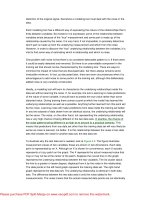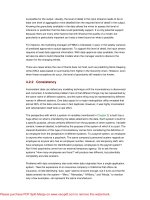Data science for modern manufacturing
Bạn đang xem bản rút gọn của tài liệu. Xem và tải ngay bản đầy đủ của tài liệu tại đây (2.28 MB, 52 trang )
Strata + Hadoop World
Data Science for Modern
Manufacturing
Global Trends: Big Data Analytics for the Industrial Internet of Things
Li Ping Chu
Data Science for Modern Manufacturing
by Li Ping Chu
Copyright © 2016 O’Reilly Media, Inc. All rights reserved.
Printed in the United States of America.
Published by O’Reilly Media, Inc., 1005 Gravenstein Highway North,
Sebastopol, CA 95472.
O’Reilly books may be purchased for educational, business, or sales
promotional use. Online editions are also available for most titles
(). For more information, contact our
corporate/institutional sales department: 800-998-9938 or
Editor: Shannon Cutt
Production Editor: Kristen Brown
Copyeditor: Octal Publishing, Inc.
Interior Designer: David Futato
Cover Designer: Karen Montgomery
Illustrator: Rebecca Demarest
July 2016: First Edition
Revision History for the First Edition
2016-06-10: First Release
The O’Reilly logo is a registered trademark of O’Reilly Media, Inc. Data
Science for Modern Manufacturing, the cover image, and related trade dress
are trademarks of O’Reilly Media, Inc.
While the publisher and the author have used good faith efforts to ensure that
the information and instructions contained in this work are accurate, the
publisher and the author disclaim all responsibility for errors or omissions,
including without limitation responsibility for damages resulting from the use
of or reliance on this work. Use of the information and instructions contained
in this work is at your own risk. If any code samples or other technology this
work contains or describes is subject to open source licenses or the
intellectual property rights of others, it is your responsibility to ensure that
your use thereof complies with such licenses and/or rights.
978-1-491-95896-4
[LSI]
Data Science for Modern
Manufacturing
Preface
When I was approached about the opportunity to write this report, I was told
that O’Reilly was looking for someone with a technical background,
experience in writing, and the ability to communicate in Mandarin Chinese to
put something together that included the topics of Big Data, Manufacturing,
Internet of Things, Made In China 2025, Industrie 4.0, and Industrial
Internet. I told them, “No problem!” and then set off to do some research.
What I found was that there is no shortage of information available — there
are literally hundreds, if not thousands, of articles and reports that on these
topics — but there aren’t a lot of straightforward answers. I began to imagine
how incredibly frustrating it would be if I were a decision maker for a
manufacturing company and I knew that we needed to act fast to kick off an
Industrial Internet project but couldn’t be certain about the quality of
information out there.
Therefore, the purpose of this report is to deliver to you the fundamentals of
the Industrial Internet — particularly if you’re in the business of “making
stuff.” With cutting edge technology, it’s impossible to write a text that will
be definitive, but I attempted to compile as much of the relevant information
in one place to help you cut through some of the jargon and marketing hype.
In this report, you will learn about what Industrial Internet is, what
governments are doing to promote Industrial Internet, the technologies that
are the backbone of the digital revolution in industry, and the challenges and
problems that you should consider. We will also closely examine the
Industrial Internet of Things (IIoT) and the role of Big Data Analytics in all
of this. We’ve also had numerous experts in the industry from around the
globe weigh in and share their thoughts and opinions. We hope that after
reading this report, you will feel properly equipped to have an informed and
meaningful conversation on these topics.
Introduction
The world’s leading nations are standing at the precipice of the next great
manufacturing revolution and their success or failure at overhauling the way
goods are produced will likely determine where they stand in the global
economy for the next several decades. Despite the uncertain economic
outlook as of this writing, the ranks of the world’s middle-income families
are still slated to balloon to 3.2 billion in 2020 and 4.9 billion in 2030 (from
1.8 billion in 2009).1 With this newfound buying power comes massive
increased demand for high-quality consumer goods at a reasonable cost. To
meet this demand will require an equivalent increase in output and efficiency
from manufacturers, and this increased output is going to come from
breakthroughs in Information Technology — in particular the Internet of
Things (IoT) and Big Data Analytics.
However, the expanding market is not the only factor driving companies to
modernize their production facilities. Increasingly, top manufacturing nations
are seeing factories move to countries where wages are lower. Companies
that have located their manufacturing in industrial powerhouses like Germany
and China are feeling the pinch as labor costs rise. For the time being,
Chinese workers can still claim to be far more efficient than their
counterparts in India and Vietnam, and Germany will remain the European
export leader for the foreseeable future due to its highly specialized industries
(in particular auto and machinery), but neither of them are content to rest on
their laurels.
Furthermore, China posted GDP growth of only 6.9 percent for 2015, which
is its weakest growth rate in 25 years. Economic projections for 2016 and
beyond suggest that the once gaudy economic expansion of the previous
decades is tapering off as the Chinese economy matures. This phenomenon is
being referred to as the “New Normal” by China’s policy makers who are
looking for ways to secure a sustainable rate of economic growth for the
future. Germany has scaled back its forecast for GDP growth to 1.7 percent
for 2016 in the wake of slowing demand from emerging markets. Both
nations are highly dependent on manufacturing exports as a component of
their economies (22.6 percent for China and 45.7 percent for Germany as of
2014)2 and are therefore more vulnerable to downturns in the economies of
their trade partners. By using smart technologies, these export goliaths are
hoping to optimize their supply chains and, in turn, minimize the effect
fluctuations in the global markets have on their local economies.
To this end, the governments of Germany and China have both drawn up
extremely ambitious plans to bring their manufacturing sectors into the 21st
century. Germany has dubbed its plan Industrie 4.0 in reference to the fourth
major industrial revolution. Taking a page from Germany’s book, the
Chinese have come up with Made in China 2025, which — in typical Chinese
fashion — is further reaching and even more expansive in its aims. This
report will present you with a comprehensive look at both of these initiatives
and closely examine the technologies that will be underpinning them as well
as the challenges ahead.
Industrial Internet
Before we can really begin to understand the details of the German and
Chinese plans, we need to define Industrial Internet. In the report “Industrial
Internet” (O’Reilly, 2013), Jon Bruner states:
The Industrial Internet is the union of software and big machines — what
you might think of as the enterprise Internet of Things, operating under the
demanding requirements of systems that have lives and expensive
equipment at stake. It promises to bring the key characteristics of the Web
— modularity, abstraction, software, above the level of a single device —
to demanding physical settings, letting innovators break down big
problems, solve them in small pieces, and then stitch together their
solutions.
Another way to wrap your mind around this concept is to first imagine a
company with several manufacturing centers. Now imagine all of the
information systems, employees, and machines (from assembly line robots to
forklifts), tools, and monitoring systems (cameras and sensors) in the
company as nodes on a network, which are in turn connected to the Internet.
Each of these nodes is constantly producing and receiving data on the current
situation in the plant and the Internet at large. As conditions change, the
individual nodes respond accordingly.
To better illustrate how this would work, let’s run through a hypothetical
scenario for a make-believe manufacturer of selfie sticks. This particular
company (which we will call Vanity Products Unlimited, or Vanity for short)
is the largest manufacturer of selfie sticks in the world. Demand is high, but
its plants usually run at around 70 percent capacity during the nonpeak
season.
In our scenario, news has hit that the second largest producer of selfie sticks
has suffered a plant fire. Although no injuries or fatalities were reported, it
will be a minimum of three months before it will be back online. Vanity’s
systems, which are always monitoring the market for relevant news about the
current marketplace, detect the event and make a number of calculations
about the unmet demand that will result from the incident. These calculations
will be based on a number of variables, including historical data, current
inventory stocks, market demand, and so on. With minimal human
interaction, the system places orders for parts and raw materials, schedules
additional personnel for plant shifts, and starts up additional production lines
at the facilities to increase output. The system also makes appropriate
logistical arrangements to ensure that the products get to the locations where
demand is highest — balancing delivery time against cost — to take
advantage of the sudden shortfall in product and maximize profits.
This is just one hypothetical example, but it gives you an idea of the potential
of how intelligent, interconnected systems combined with inexpensive
sensors will be crucial to the future of business. The truth is, the potential for
the Industrial Internet is nearly infinite and will only increase as more
information and experience is acquired over time, revealing patterns and
trends in the oceans of data that are being created. Although this example is
focused on a manufacturing business, the Industrial Internet will touch all
sectors, from medical care to petroleum production. With so many different
industries and so much technology, who is going to ensure that all of this
hardware and software from various different vendors is going to be
compatible? Enter the Industrial Internet Consortium.
The Industrial Internet Consortium
The Industrial Internet Consortium (IIC) is a not-for-profit partnership
established in March 2014 with the stated goal to, in its words, “accelerate
the growth of the Industrial Internet by identifying, assembling, and
promoting best practices.” Its membership is international and consists of
companies of all sizes, universities, researchers, academics and government
organizations.
The consortium concentrates on three key areas, technology, testbeds, and
security, to address issues regarding interoperability, connectivity, and
security. It is extremely important to note that unlike most other technology
consortiums (such as IEEE or W3C), the IIC has not been founded on the
principle on creating standards. Rather, it is a facilitator of testbeds and
dialog between the disparate member organizations, with the intention of
giving them a common place to work together. The hope is that this
cooperation will organically create common standards and reference designs
that will be adopted across the various industries and verticals.
It should be noted that the IIC is not the only game in town when it comes to
standards groups. Well before the IIC was formed, there was the Internet
Protocol for Smart Objects (IPSO) Alliance, whose goal is to establish the
Internet Protocol as the generally agreed upon protocol for IoT for the
energy, consumer, healthcare, and industry areas. Other names that you might
hear associated with IoT standardization are the AllSeen Alliance, the Thread
Group and the Open Connectivity Foundation. However, the IIC, unlike these
groups is solely focused on the industrial sector. On the other hand, over in
Europe you have the Plattform Industrie 4.0 (the committee led by the
German government to carry out the recommendations laid out by the
Industrie 4.0 Working Group in 2013) and Mantis, a cooperative between
various universities in the EU and private industry whose goal, in its words,
is to “develop a Cyber Physical System-based Proactive Maintenance Service
Platform Architecture, enabling Collaborative Maintenance Ecosystems.”
Industrie 4.0
Industrie 4.0 is the German initiative to implement the technology and
philosophies of the Industrial Internet. The first mention of the term Industrie
4.0 was at the Hannover Fair in October 2011, and subsequently it was
adopted as part of the broader High-Tech Strategy 2020 in November of the
same year. This was soon followed up by the formation of the Industrie 4.0
Working Group in January 2012.
The working group consisted of leading academics, researchers, and experts
in a number of fields, such as information and communication technologies,
production research and user industries, for the purpose of determining
strategies and making recommendations on how to move forward. The
responsibility of coordination and oversight went to the German Academy of
Science and Engineering (Acatech) and was chaired by Dr. Siegfried Dais,
who at the time was the deputy chairman of management at Bosch Industries,
and Henning Kagermann of the Academy. The final draft of the findings and
recommendations by the committee were presented at the 2013 Hannover
Fair.
The report led to the creation of the Plattform Industrie 4.0, which is the
alliance for the coordination of Germany’s industrial digitization efforts. It is
led by the German Ministry of Economic Affairs and Energy and the
Ministry Education and Research. The government’s hands-on role and their
investment of €200 million for research demonstrates its deep commitment to
the success of the initiative.
The Plattform itself has many striking similarities to the IIC. For starters, it
was founded with the goal of bringing together leaders in academia, industry,
and government for the purpose of tackling the major issues involving the
implementation of Industrial Internet practices. Also similar to the IIC, the
platform has a number of working groups dedicated to trying to solve the
technical issues around Industrial Internet. In the case of Plattform Industrie
4.0, the working groups are broken down according to their concentration in
the following areas:
Reference architectures, standards, and norms
Research and innovation
Networked systems
Legal framework
Work, education, and training
However, unlike the IIC, Plattform Industrie 4.0 is purposely taking a less
proactive role in helping to create standards. It has instead chosen to focus on
a more advisory role, making recommendations and bringing together the
various stakeholders together to discuss the issues and coordinate efforts. The
committee then supports the projects to which the discussions give rise.
However, the actual implementation is still left to the outside organizations.
The reach of Industrie 4.0 will not be confined to Germany, either. German
Chancellor Angela Merkel is using her extensive influence on the other EU
member states to begin adopting the Industrial Internet ethos. She has even
gone on to state that her nation would actively cooperate with China to link
the Industrie 4.0 and Made In China 2025 strategies. For Germany, as one of
the leading suppliers of industrial machinery in the world, encouraging her
trade partners to upgrade their manufacturing systems represents a massive
business opportunity.
Also very much worth mentioning is the interoperability agreement between
the IIC and the Plattform. In March 2016, the two groups agreed to a “clear
roadmap to ensure future interoperability” with the possibility for more direct
collaboration on test beds and standards development down the road.3 It is
likely that the two sides bent to the demands of many of the major players
such as Bosch, Cisco, and Siemens, who are on the steering committee of
both and likely felt they were duplicating their efforts. The consensus is that
this will lead to less incompatibility between standards and more adoption of
Industrial Internet overall.
Made in China 2025
Made in China 2025 is China’s answer to Germany’s Industrie 4.0, but it is
even broader in its ambitions. The initiative was officially unveiled in May
2015 after it was first announced at the Lianghui Meeting earlier in March of
the same year. It is the product of two and a half years of work by the
Chinese Ministry of Industry and Information Technology (MIIT) with input
from experts from the China Academy of Engineering. In many ways, Made
in China 2025 is meant to replace the Strategic Emerging Industries approach
of the previous administration (led by Hu Jintao and Wen Jiabao) to advance
the country’s objective to become a global innovator.
So what exactly is the goal of this new strategy being adopted by China? In
the words of Premier Li Keqiang, it is to:
…seek innovation-driven development, apply smart technologies,
strengthen foundations, pursue green development and redouble our efforts
to upgrade China from a manufacturer of quantity to one of quality.
Analyzing the text of the policy, we can break it down into several
components:
Innovation
Global investors have been bearish about China’s economic situation
over the past year with the country’s GDP growth slowing to around 7
percent. However, the Chinese government seems to view the situation
differently. It has embraced it as the “New Normal” and has set an
annual growth target of 6 to 7 percent through the year 2020. Although
some second-tier cities that rely on industries like steel production are
experiencing recession, highly skilled workers are in huge demand in
cities like Shanghai which are still seeing double-digit growth. Made in
China 2025 is one of Beijing’s tools for encouraging the expansion of
the “new economy” as it begins to deemphasize construction, heavy
industry, and commodity production that were largely state-owned or
assisted. Investing in R&D, creating industry standards, and amassing IP
are crucial to the strategy of transforming the country from a producer of
raw materials and assembler of goods to a global innovation leader.
Quality over quantity
China accounts for 25 percent of all global production and is the leading
manufacturer of mobile phones, air conditioners, and shoes, among
other products. Top brands known for their excellence, such as Apple,
Samsung, Nike, and Toyota, all have massive production facilities in the
country or outsource to manufacturers in China. Despite this, the term
“Made in China” is still largely synonymous with cheap, poorly made,
and disposable products. This is not only a result of the many years of
producing low-end goods, but also because a significant proportion of
China’s exports are still not manufactured with quality in mind.
Therefore, one of the the key components to Made in China 2025 is the
emphasis on improving quality across the board so that local brands can
flourish outside of the country. This is not unlike how Korean brands
like Samsung transitioned in the mid-2000s from being a manufacturer
of commodity household appliances to competing with Japanese and
American brands like Apple and Sony at the upper end of the consumer
electronics sector based on the merits of their build and design
standards.
Green development
Even though China has, in the past, endured a fair bit of criticism for its
perceived lack of environmental policy, Made in China 2025
demonstrates that Beijing is serious about cleaning up its act. In fact, the
word “green” appears 46 times in the document text. The end goal here
is to not only create products that are environmentally friendlier, but to
build an industrial chain that is green at all levels. Their motivation for
this couldn’t be more straightforward: China understands that creating
new green factories and retrofitting existing facilities to be cleaner and
more energy-efficient not only has a positive environmental impact, it’s
an opportunity for economic growth.
Apply smart technologies
The crux of Made in China 2025 comes down to modernizing the
manufacturing sector by using smart technologies. This is to say that the
state intends to realize the preceding points by applying the tenets of the
Industrial Internet. It has been noted by many that China has fallen
behind in bringing some of its older factories up to current specifications
and many processes that should be automated are still being done en
masse by human hands. The slowdown in Europe and the US gives
China the opportunity to catch up with heavy investment in high-tech
tooling, robotics, networks, and computer systems. On the other end, the
leading manufacturers in the nation, who have consistently made
investments to keep their facilities up to date, will be given additional
support from the state. China is the largest market in the world for
industrial automation and robots, and with Made in China 2025 it will
become even bigger, while simultaneously expanding the role of IoT
and Big Data Analytics.
The state’s plan to ensure the success of Made in China 2025 comes in the
form of subsidies and incentives, policy reform, and financing for projects to
further these goals. To encourage invention, Beijing will tighten up
intellectual property rights protection — particularly for small and mediumsized enterprises. It will also create manufacturing innovation centers
throughout the nation, with the goal of having 15 up and running by 2020,
and 40 by 2025.
It is also important to note that Made In China 2025 dovetails with another
major initiative known as Internet Plus. As you can probably tell from the
proposal’s name, the idea is to upgrade the Internet in China. This will
involve improvements to the network infrastructure and expansion of
broadband availability as well as the integration of mobile Internet, cloud
computing, Big Data, and IoT. It also entails converging consumer IoT with
IIoT technology in a variety of sectors, including medicine, government, and
finance. In terms of the manufacturing area, the idea is that consumer IOT
will enable companies to gather data, monitor, and remotely control machines
and devices among many other functions. The data gathered informs the
manufacturer of the performance of their products under real-world scenarios,
which can be fed into their systems for analysis. This in turn improves
efficiency and quality throughout the entire supply chain.
In the opinion of Wang YaBing, senior consultant for Baifendian — one of
China’s leading Big Data consulting companies — Made in China 2025
represents an opportunity for China to drag some of its industries into the
modern age:
These types of more traditional manufacturers, who have mostly not
utilized the Internet, will be able to take advantage of these new models to
make massive advances in a number of areas which include logistics,
production, and sales and marketing.
Mr. Wang has said that at Baifendian they are already in the process of
implementing several Industrial Internet projects with companies in the
pharmaceutical and accessories industries. Their technology is also at the
heart of a system to monitor and detect failure for TV broadcast equipment.
He also added that, although China is putting effort into trying to help small
and medium-sized manufacturers compete, it’s likely that the nation will see
the rise of mega corporations, as the technology gap increases between the
larger firms and small and medium-sized companies:
For example, (the state government) is assisting with implementation of
many modernization projects. Many manufacturing and Internet
technology companies are teaming up to innovate in the design of new
products — and in this area the Chinese Government is quite supportive…
However, these are the top thousand companies in the nation with
experienced staff and resources to execute projects of this type. However,
small and medium sized manufacturers — such as companies in the metals
and the fast-moving consumer goods (FMCG) industries — are going to
face a number of tough challenges catching up. And, I think it’s likely that
many of these companies will be absorbed into larger firms and it’s very
possible that China will experience a situation similar to Japan where you
have a number of mega-sized companies dominating the market in the
future.
(Industrial) Internet of Things
This Internet of Things (IoT) is garnering a massive amount of attention in
the media. When applied to the industrial area, it is commonly referred to at
the Industrial Internet of Things, or IIoT. In this section, we will examine
how IIoT tech is going to revolutionize how manufacturing gathers and
processes data. We will also examine a real-world example of a company
that’s taken the plunge and realized real gains as a result of implementing
IIoT.
Before we dig deeper, we should probably take a moment to clarify what
IIoT actually is. The truth is there is no consensus on the exact definition of
the term. In many publications, IIoT and Industrial Internet are one and the
same — it is the whole package from the Big Data Analytics systems, to the
automation and robotics, to sensors and monitoring devices, and beyond. On
the other hand, others consider IIoT to be limited to the embedded systems,
controls, sensors, and monitors on industrial equipment and the software
systems powering them. For this purposes of this report, we will go with this
definition.
The standard definition of the IoT is “the network of physical objects —
devices, vehicles, buildings, and other items — embedded with electronics,
software, sensors, and network connectivity that enables these objects to
collect and exchange data.”4 This definition omits any mention of the
backend systems involved in processing the data. At times you’ll even see the
term Industrie 4.0 used interchangeably with Industrial Internet. Whenever
industry buzzwords take off, there will always be discrepancies in their
interpretation and a variety of interests that want to control the terminology.
If you are even a casual observer of technological trends, you know how
hyped the IoT has been in recent years. The number of Internet-connected
devices will be more than 20 billion within 5 years by reasonable estimates,
and adoption will only accelerate from there.5 Although it is important to
distinguish the industrial side of IoT tech from the consumer and commercial
sides, there will be a symbiotic relationship between all of them, and
successful implementation of all three will be necessary for corporations with
their eyes on the future.
When specifically talking about IIoT in manufacturing, the focus tends to be
equipping assets with sensors and/or networking capabilities. These assets
include everything from the parts in inventory, to the machines on the
production line, to the facilities themselves. By monitoring the state of
machines and the products as they are being manufactured, a much higher
resolution picture of what is happening at any particular moment can be
assessed in ways that would have simply been impossible in the past.
It should also be noted that even though a lot has been made of attaching
relatively inexpensive sensors and network adapters to existing and new
industrial machines as the breakthrough innovation in IIoT, the fact is that
nearly all industrial machines already come equipped with a plethora of
sensors and a large percentage also have some type of networking capability.
Although this sounds like it would save a great deal of effort, the truth is that
it more often creates its own unique set of challenges. For decades,
manufacturers of industrial equipment have developed data formats,
protocols, and even networking hardware that are industry specific or even
proprietary. So, whereas the IT industry has now evolved to the point where
commodity hardware and protocols have become the de facto standard for
nearly all except the most specialized applications, the manufacturing world
remains extremely fragmented. Regarding the variety of machines, protocols,
and data formats in the industrial space, Nathan Oostendorp, CTO and
cofounder of Sight Machine, explains:
As far as the number of types of machines, tens of thousands to hundreds
of thousands is pretty conservative. There’s a lot of automation that is built
to spec. With transport mechanisms and protocols, that’s covered by a
couple dozen cases. But in terms of what the data says and how it needs to
be mapped, that is really a massive variety problem and I don’t think it’s
something where you’re going to be able to compile the list of all known
machines and walk into a plant completely cold and have a turnkey
solution that takes all of its data automatically and gives you a perfect
digital picture of what’s going on. There’s always going to have to be
some amount of modeling that goes on, and some information that comes
from the process itself that will inform how you’re going to report on that
data.
A Platform Built for Manufacturing
Despite these hurdles, Sight Machine has seen real-world success with its
product, which they tout as a “Big Data Analytics platform that was built
exclusively for the manufacturing industry.” One such case Oostendorp went
on to describe involved a major automobile manufacturer that was able to
reduce the number of defective parts being produced by applying Industrial
Internet principles:
One of the Big Three automakers was really interested in understanding
the root cause of quality problems. It was really like an internal supply
chain–type problem. A part would be cast at one plant, machined at
another plant, assembled in a third plant. At every stage different
serialization schemes were being used. Different tests were being
performed, but the data wasn’t necessarily being fed to the process
upstream in order for them to improve their processes. So when they
instrumented this process with Sight Machine, it allowed all the plants to
look at the same data and to understand how things that were happening in
the casting process or the machining process had an impact all the way
down to when the pieces were finally fit and what sort of defect states were
in that. This solved a really big problem that had been plaguing this
company. With Sight Machine, they detected and eliminated 5 times the
defects they suspected they were suffering.
Most initial Industrial Internet initiatives are focusing on what many consider
the low-hanging fruit for their initial trials. A couple of goals that you’ll see
mentioned repeatedly are the concepts of doing predictive maintenance and
anomaly detection. This tends to be because these are the problems that are
the easiest to tackle and obtain a high return on investment. We will discuss
these two particular use cases in further detail later on.
But the fact remains that the vast majority of legacy equipment and machines
are not IIoT-ready. Matthew McNeely, founder and head designer and
engineer at Nimble Industry — a company that has developed a product that
lets industrial equipment manufacturers equip their new and existing
machines with IIoT capabilities — puts it succinctly by saying:
Not until industrial equipment manufacturers begin embedding modern
distributed computing intelligence into their products will the full potential
of the Industrial Internet be realized.
Big Data and Analytics









